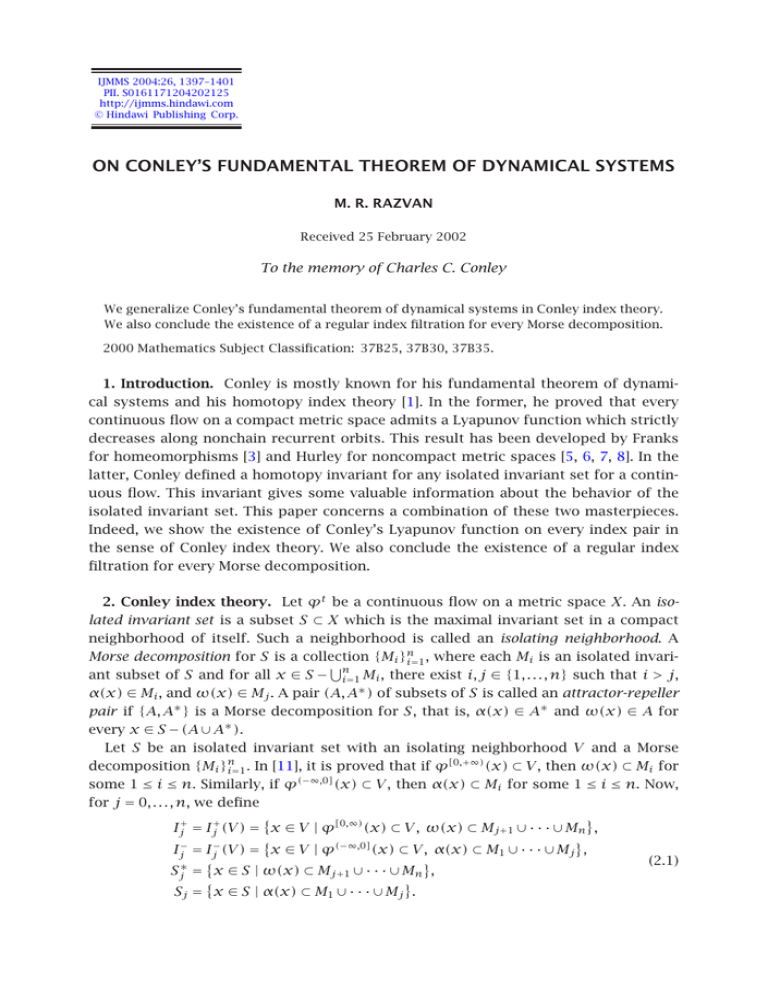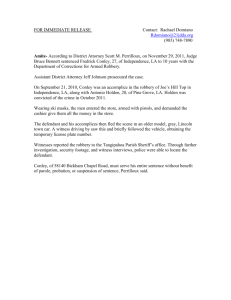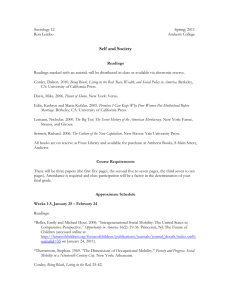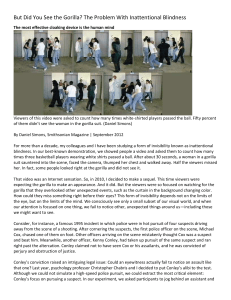ON CONLEY’S FUNDAMENTAL THEOREM OF DYNAMICAL SYSTEMS M. R. RAZVAN
advertisement

IJMMS 2004:26, 1397–1401
PII. S0161171204202125
http://ijmms.hindawi.com
© Hindawi Publishing Corp.
ON CONLEY’S FUNDAMENTAL THEOREM OF DYNAMICAL SYSTEMS
M. R. RAZVAN
Received 25 February 2002
To the memory of Charles C. Conley
We generalize Conley’s fundamental theorem of dynamical systems in Conley index theory.
We also conclude the existence of a regular index filtration for every Morse decomposition.
2000 Mathematics Subject Classification: 37B25, 37B30, 37B35.
1. Introduction. Conley is mostly known for his fundamental theorem of dynamical systems and his homotopy index theory [1]. In the former, he proved that every
continuous flow on a compact metric space admits a Lyapunov function which strictly
decreases along nonchain recurrent orbits. This result has been developed by Franks
for homeomorphisms [3] and Hurley for noncompact metric spaces [5, 6, 7, 8]. In the
latter, Conley defined a homotopy invariant for any isolated invariant set for a continuous flow. This invariant gives some valuable information about the behavior of the
isolated invariant set. This paper concerns a combination of these two masterpieces.
Indeed, we show the existence of Conley’s Lyapunov function on every index pair in
the sense of Conley index theory. We also conclude the existence of a regular index
filtration for every Morse decomposition.
2. Conley index theory. Let ϕt be a continuous flow on a metric space X. An isolated invariant set is a subset S ⊂ X which is the maximal invariant set in a compact
neighborhood of itself. Such a neighborhood is called an isolating neighborhood. A
Morse decomposition for S is a collection {Mi }n
i=1 , where each Mi is an isolated invarin
ant subset of S and for all x ∈ S − i=1 Mi , there exist i, j ∈ {1, . . . , n} such that i > j,
α(x) ∈ Mi , and ω(x) ∈ Mj . A pair (A, A∗ ) of subsets of S is called an attractor-repeller
pair if {A, A∗ } is a Morse decomposition for S, that is, α(x) ∈ A∗ and ω(x) ∈ A for
every x ∈ S − (A ∪ A∗ ).
Let S be an isolated invariant set with an isolating neighborhood V and a Morse
[0,+∞)
(x) ⊂ V , then ω(x) ⊂ Mi for
decomposition {Mi }n
i=1 . In [11], it is proved that if ϕ
some 1 ≤ i ≤ n. Similarly, if ϕ(−∞,0] (x) ⊂ V , then α(x) ⊂ Mi for some 1 ≤ i ≤ n. Now,
for j = 0, . . . , n, we define
Ij+ = Ij+ (V ) = x ∈ V | ϕ[0,∞) (x) ⊂ V , ω(x) ⊂ Mj+1 ∪ · · · ∪ Mn ,
Ij− = Ij− (V ) = x ∈ V | ϕ(−∞,0] (x) ⊂ V , α(x) ⊂ M1 ∪ · · · ∪ Mj ,
(2.1)
Sj∗ = x ∈ S | ω(x) ⊂ Mj+1 ∪ · · · ∪ Mn ,
Sj = x ∈ S | α(x) ⊂ M1 ∪ · · · ∪ Mj .
1398
M. R. RAZVAN
Moreover, if (A, A∗ ) is an attractor-repeller pair for S, we set
IA+∗ = x ∈ V | ϕ[0,∞) (x) ⊂ V , ω(x) ⊂ A∗ ,
IA− = x ∈ V | ϕ(−∞,0] (x) ⊂ V , α(x) ⊂ A .
(2.2)
In [2, 11], it is proved that Ij+ and Ij− are compact and (Sj , Sj∗ ) is an attractor-repeller
pair for S. This fact allows us to prove our results for an attractor-repeller pair and
then extend them to every Morse decomposition.
In order to define the concept of index pair, we follow [9, 11]. Given a compact pair
(N, L) with L ⊂ N ⊂ X, we define the induced semiflow on N/L by
ϕ#t
: N/L → N/L,
ϕ#t (x)
ϕt (x)
=
[L]
if ϕ[0,t] (x) ⊂ N − L,
otherwise.
(2.3)
In [9], it is proved that ϕ#t is continuous if and only if
(i) L is positively invariant relative to N, that is,
x ∈ L, t ≥ 0,
ϕ[0,t] (x) ⊂ N ⇒ ϕ[0,t] (x) ⊂ L,
(2.4)
(ii) every orbit which exits N goes through L first, that is,
x ∈ N,
ϕ[0,∞) (x) ⊂ N ⇒ ∃t ≥ 0,
ϕ[0,t] (x) ⊂ N,
ϕt (x) ∈ L,
(2.5)
or equivalently if x ∈ N − L, then there is a t > 0 such that ϕ[0,t] (x) ⊂ N.
Definition 2.1. An index pair for an isolated invariant set S ⊂ X is a compact pair
(N, L) in X such that N − L is an isolating neighborhood for S and the semiflow ϕ#t
induced by ϕt is continuous.
In [1, 2, 9, 11], it has been shown that every isolated invariant set S admits an index
pair (N, L) and the homotopy type of the pointed space N/L is independent of the
choice of the index pair. The Conley index of S is the homotopy type of (N/L, [L]).
Note 2.2. We will not distinguish between N − L and N/L − {[L]}.
Definition 2.3. An index pair (N, L) is called regular if the exit time map defined
by
τ+ : N → [0, +∞],
τ+ (x) =
sup t | ϕ[0,t] (x) ⊂ N − L
if x ∈ N − L,
0
if x ∈ L,
(2.6)
is continuous.
Proposition 2.4. An index pair (N, L) is regular provided that ϕ[0,t] (x) ⊂ N − L for
every x ∈ L and t > 0.
ON CONLEY’S FUNDAMENTAL THEOREM OF DYNAMICAL SYSTEMS
1399
The above result provides a criterion for the regularity of index pairs. The reader
is referred to [11] for the details about regular index pairs and the proof of this useful
criterion.
Definition 2.5. Let S be an isolated invariant set with a Morse decomposition
{Mi }n
i=1 . An index filtration is a sequence N0 ⊂ N1 ⊂ · · · ⊂ Nn of closed subsets of
X such that (Nk , Nk−1 ) is an index pair for Mk for every 1 ≤ k ≤ n and (Nn , N0 ) is an
index pair for S. When each (Nk , Nk−1 ) is regular, then the above filtration is called a
regular index filtration.
It is well known that every Morse decomposition admits an index filtration [11]. We
desire to show that every Morse decomposition admits a regular index filtration.
3. Conley’s fundamental theorem. In this section, we construct a Lyapunov function
on an index pair by modifying Conley’s original argument [1, 10]. The key point is that
one should work with IA+∗ and [L]∪IA− instead of the attractor-repeller pair (A, A∗ ). The
following lemma is the main idea in the proof of the continuity of Conley’s Lyapunov
function.
Lemma 3.1. Let S be an isolated invariant set with an attractor-repeller pair (A, A∗ ),
an index pair (N, L), and the isolating neighborhood V = N − L. If B is a compact subset
of N/L − IA+∗ and U is a neighborhood of [L] ∪ IA− , then there exists T ∈ R+ such that
[T ,+∞)
(B) ⊂ U.
ϕ#
Proof. We may assume that U is a compact neighborhood of [L] ∪ IA− with U ∩
t
= . Now, suppose that there are xn ∈ B and tn → ∞ such that ϕ#n (xn ) ∈ U.
Since B is compact, we may choose xn ’s in N − L so that xn → x ∈ B. It is easy
to see that ϕ[0,+∞) (x) ⊂ N − L. Since B ∩ IA+∗ = , we have ω(x) ⊂ A, hence there
IA+∗
◦
is a t ∈ R+ such that ϕ[t,+∞) (x) ∈U . Since xn → x, there are tn
∈ [t, tn ] such that
◦
tn
− t → ∞, ϕ[t,tn ) (xn ) ⊂U , and ϕtn (xn ) ∈ ∂U for every sufficiently large n ∈ N. There
fore, the sequence ϕtn (xn ) has a limit point y ∈ ∂U such that ϕ(−∞,0] (y) ⊂ U ∩(N −L)
and y ∈ ω(B) ⊂ S. Thus, α(y) ⊂ A, which means that y ∈ I − (A). This contradicts
y ∈ ∂U .
Theorem 3.2. Let S be an isolated invariant set with an attractor-repeller pair (A, A∗ )
and an index pair (N, L). There exists a continuous function g : N/L → [0, 1] such that
(i) g −1 (0) = [L] ∪ IA− and g −1 (1) = IA+∗ ,
(ii) g(ϕ#t (x)) < g(x) for every x ∈ [L] ∪ IA− ∪ IA+∗ and t ∈ R+ .
Proof. Let ρ : N/L → [0, 1] be a continuous function with ρ −1 (0) = [L] ∪ IA− and
ρ (1) = IA+∗ . We define h : N/L → [0, 1] by h(x) = supt≥0 ρ(ϕ#t (x)). It is not hard
to see that h−1 (0) = [L] ∪ IA− , h−1 (1) = IA+∗ . We show that h is upper-semicontinuous.
For every x ∈ N/L and > 0, there is a t ∈ R+ such that ρ(ϕ#t (x)) > h(x) − . Now,
there is a neighborhood U such that ρ(ϕ#t (y)) > h(x) − for every y ∈ U. Therefore,
h(y) > h(x) − for every y ∈ U , which proves the upper-semicontinuity of h. As a
result, h is continuous in h−1 (1). Now, suppose that x ∈ h−1 (1) = IA+∗ and < 1−h(x).
If we set B = ρ −1 [0, h(x) + ] and U = ρ −1 [0, h(x) + ) in the above lemma, we obtain
−1
1400
M. R. RAZVAN
a T ∈ R+ with ρ(ϕ#t (y)) < h(x)+ for every y ∈ B and t ≥ T . Now, the by continuity of
ϕ# , there exists an open set V ⊂ N/L such that x ∈ V and ρ(ϕ#t (y)) < h(x)+ for every
t ∈ [0, T ] and y ∈ V . Therefore, h(y) < h(x)− for every y ∈ U ∩V , which shows that
+∞
h is lower-semicontinuous in x. Now, it is left to check that g := 0 e−t h(ϕ#t (x))dt is
the desired function.
Theorem 3.3. Let S be an isolated invariant set with an index pair (N, L) and a Morse
decomposition {Mi }n
i=1 . There is a continuous function g : N/L → [0, n + 1] such that
(i) g −1 (0) = [L] and g(Mi ) = i for every 1 ≤ i ≤ n,
n
(ii) if x ∈ N − L − i=1 Mi and t > 0, then g(ϕ#t (x)) < g(x).
Proof. Consider the attractor-repeller pairs (Sj , Sj∗ ) for 0 ≤ j ≤ n. By Theorem 3.2,
there are continuous functions gi : N/L → [0, 1] with gi−1 (0) = [L] ∪ Ij− , gi−1 (1) = Ij+ ,
and gj (ϕt (x)) < gj (x) for every x ∈ [L]∪Ij− ∪Ij+ . Now, g := g0 +· · ·+gn is the desired
function.
Corollary 3.4. Every Morse decomposition admits a regular index filtration.
Proof. Let f be the above Lyapunov function. If we set Nk := π −1 (f −1 [0, k + 1/2])
for 0 ≤ k ≤ n and Nn := N, then, by Proposition 2.4, (Nk , Nk−1 ) is a regular index pair
for Mk , for every 1 ≤ k ≤ n.
Definition 3.5. Let ϕt be a continuous flow on a compact metric space X. An chain for ϕt is a sequence x0 , . . . , xn in X and t1 , . . . , tn in [1, +∞) such that d(ϕti (xi−1 ),
xi ) < . A point x ∈ X is called chain-recurrent if for every > 0, there is an -chain
with x0 = xn = x. The set of all chain recurrent points for ϕt is denoted by R(ϕt ).
It is not hard to check that R(ϕt ) is a closed invariant subset of X containing the
nonwandering set Ω(ϕt ). In [1, 10], it has been shown that R(ϕt |R(ϕt ) ) = R(ϕt ) and
R(ϕt ) = (A ∪ A∗ ), where the intersection is taken over all attractor-repeller pairs
(A, A∗ ) in X. It is also known that the number of all attractor-repeller pairs in a compact
metric space is at most countable.
Theorem 3.6. Let S be an isolated invariant set with an index pair (N, L). Then there
is a continuous function g : N/L → [0, 1] such that
(i) g −1 (0) = [L] and g(ϕ#t (x)) ≤ g(x) for every x ∈ N/L and t ≥ 0,
(ii) if x ∈ N − L − R(ϕt |S ) and t ≥ 0, then g(ϕ#t (x)) < g(x).
∞
Proof. Let {(Ai , A∗
i )}i=1 be the sequence of all attractor-repeller pairs in S including
(, S) and (S, ). Now, by Theorem 3.2, there are continuous functions gi : N/L → [0, 1]
such that gi−1 (0) = [L] ∪ IA−i , gi−1 = IA+∗ , and gi (ϕ#t (x)) < gi (x) for every t ∈ R+ and
i
∞
x ∈ [L] ∪ IA+∗ ∪ IA−i . Now, g = i=1 2−i gi is the desired function.
i
The above result can be considered as a generalization of Conley’s fundamental theorem of dynamical systems. A similar result for discrete dynamical systems can be
obtained by following [4, 12].
Acknowledgment. The author would like to thank the Institute for Studies in Theoretical Physics and Mathematics (IPM) for supporting this research.
ON CONLEY’S FUNDAMENTAL THEOREM OF DYNAMICAL SYSTEMS
1401
References
[1]
[2]
[3]
[4]
[5]
[6]
[7]
[8]
[9]
[10]
[11]
[12]
C. Conley, Isolated Invariant Sets and the Morse Index, CBMS Regional Conference Series
in Mathematics, vol. 38, American Mathematical Society, Rhode Island, 1978.
C. Conley and E. Zehnder, Morse-type index theory for flows and periodic solutions for
Hamiltonian equations, Comm. Pure Appl. Math. 37 (1984), no. 2, 207–253.
J. Franks, A variation on the Poincaré-Birkhoff theorem, Hamiltonian Dynamical Systems
(Boulder, Colo, 1987), Contemp. Math., vol. 81, American Mathematical Society,
Rhode Island, 1988, pp. 111–117.
J. Franks and D. Richeson, Shift equivalence and the Conley index, Trans. Amer. Math. Soc.
352 (2000), no. 7, 3305–3322.
M. Hurley, Chain recurrence and attraction in noncompact spaces, Ergodic Theory Dynam.
Systems 11 (1991), no. 4, 709–729.
, Noncompact chain recurrence and attraction, Proc. Amer. Math. Soc. 115 (1992),
no. 4, 1139–1148.
, Chain recurrence, semiflows, and gradients, J. Dynam. Differential Equations 7
(1995), no. 3, 437–456.
, Lyapunov functions and attractors in arbitrary metric spaces, Proc. Amer. Math.
Soc. 126 (1998), no. 1, 245–256.
J. W. Robbin and D. Salamon, Dynamical systems, shape theory and the Conley index, Ergodic Theory Dynam. Systems 8∗ (1988), no. Charles Conley Memorial Issue, 375–
393.
C. Robinson, Dynamical Systems, Studies in Advanced Mathematics, CRC Press, Florida,
1995.
D. Salamon, Connected simple systems and the Conley index of isolated invariant sets, Trans.
Amer. Math. Soc. 291 (1985), no. 1, 1–41.
A. Szymczak, The Conley index for discrete semidynamical systems, Topology Appl. 66
(1995), no. 3, 215–240.
M. R. Razvan: Institute for Studies in Theoretical Physics and Mathematics, P.O. Box 193955746, Tehran, Iran
E-mail address: razvan@ipm.ir





